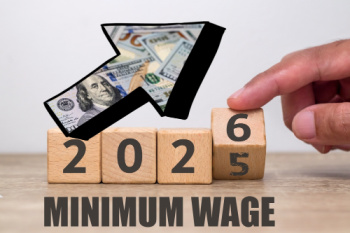What employers need to know
 |
New York State’s next round of wage increases takes effect on January 1, 2026, bringing changes that affect both non-exempt and exempt employees. Employers should begin preparing now to ensure compliance, adjust budgets, and update employee communications before the new rates go into effect.
Minimum Wage Increases for 2026
New York’s minimum wage will rise again on January 1 as part of the state’s multi-year schedule of increases:
New York City, Long Island, and Westchester County: $17.00 per hour
Remainder of New York State: $16.00 per hour
Employers should review wages for employees currently earning at or near the minimum wage. Adjustments may be necessary to maintain internal equity, preserve wage differentials, and update job postings or hiring ranges for early-2026 positions.
Hospitality Industry Minimum Wage and Tip Credits
Under the New York State Hospitality Wage Order (Part 146), restaurants and hotels have separate rules governing minimum wages, tipped employees, and tip credits. Tipped employees may be paid a lower cash wage as long as their tips make up the difference between that cash wage and the full minimum wage. The difference between the required minimum wage and the permitted cash wage is the maximum tip credit an employer may claim. Employers must ensure that an employee’s combined cash wage and actual tips always meet or exceed the applicable full minimum wage for their region; if not, the employer must make up the difference.
Cash Wage and Tip Credit Structure for 2026
Food Service Workers — NYC, Long Island, Westchester:
Cash wage: $11.35 per hour
Maximum tip credit: $5.65 per hour
Food Service Workers — Remainder of New York State:
Cash wage: $10.70 per hour
Maximum tip credit: $5.30 per hour
Employers must ensure that the combined cash wage + tips meet or exceed the full regional minimum wage ($17.00 or $16.00, depending on location).
The hospitality wage order also includes allowances for meals, lodging, and utilities in certain hotel or resort-style settings, and employers should confirm whether any of those credits apply to their operations.
Minimum Wage for Home Health Aides
New York maintains separate statutory wage rates for home health care workers. Effective January 1, 2026:
New York City, Long Island, and Westchester County: $19.65 per hour
Remainder of New York State: $18.65 per hour
Agencies should ensure their payroll, billing, and contract structures reflect these updated statutory amounts.
2026 Exempt Salary Thresholds
Exempt and non-exempt employee classifications determine whether an employee is entitled to overtime pay under federal and state law. Non-exempt employees must be paid overtime at time-and-a-half for all hours worked over 40 in a workweek. Exempt employees, however, are not eligible for overtime if they meet both the applicable duties test and the minimum salary threshold.
While the terms “exempt/non-exempt” are often used interchangeably with “salary/hourly,” they are not technically the same thing. Most exempt employees are paid a salary, and most non-exempt employees are paid hourly, but the method of pay does not determine exemption status.
The salary threshold exists to ensure exempt employees are compensated at a level commensurate with the responsibilities expected in certain executive, administrative, and professional roles. If an employee does not meet both the duties test and the salary requirement, the employee must be classified as non-exempt and paid overtime accordingly.
New York State sets its own exempt salary thresholds for the executive and administrative exemptions. These thresholds increase on January 1, 2026:
NYC, Long Island, and Westchester County:
$1,275 per week (annualized $66,300)
Remainder of New York State:
$1,199.10 per week (annualized $62,353.20)
An employee must meet both the applicable salary threshold and the duties test to qualify for exemption.
Professional Exemption Rules
New York State does not set a separate salary threshold for the “professional” exemption. Instead, federal FLSA standards apply.
Current federal exempt salary threshold: $684 per week (annualized $35,568)
There have been no changes to the federal threshold since the DOL’s 2024–2025 increases were struck down earlier this year.
Highly Compensated Employee Exemption
The federal highly compensated employee (HCE) exemption remains unchanged for 2026, remaining at $107,432. While the HCE compensation threshold is not increasing, employees must continue to perform at least one exempt duty associated with the executive, administrative, or professional exemptions. As New York’s own exempt salary thresholds rise in 2026, employers should take this opportunity to review any employees classified under the HCE exemption to confirm they continue to meet the federal duties standard.
Next Steps for Employers
Employers should begin preparing for the 2026 changes by taking the following steps:
Reviewing all hourly employees whose earnings are at or near the new general, hospitality, and home health wage rates;
Identifying exempt employees earning near the updated salary thresholds;
Issuing written notices to any employees whose pay must increase due to the minimum wage or salary threshold changes;
Ensuring managers and payroll/HR staff understand how these changes affect scheduling, classification, and pay practices.
Updated minimum wage posters are now available for download from the "Posters" section of the HR One website (Member Login above) or from the Department of Labor website.
For HR One Clients
HR One has developed Exemption Worksheets to help employers evaluate whether individual employees may qualify for an exemption under state/federal standards. This is particularly useful when reviewing borderline roles or positions with mixed responsibilities. It is important to note that to qualify for an exemption, the employee must meet both the duties test and the minimum salary threshold.
Related articles:
2026 Paid Family Leave Contribution and Benefit Rates Announced
What New York’s 2026 Budget Means for Small Business Unemployment Costs